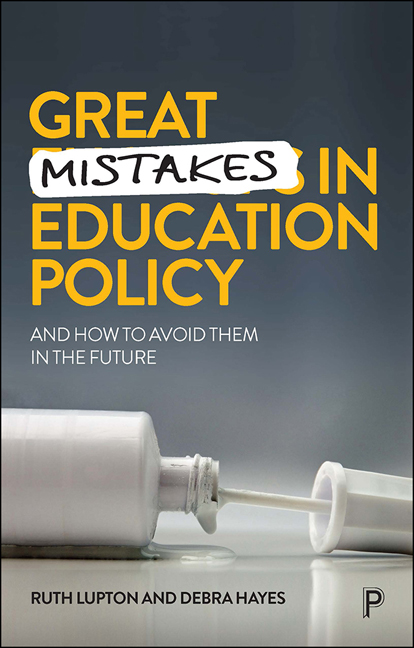Book contents
- Frontmatter
- Contents
- List of tables and boxes
- List of abbreviations
- Notes on the authors
- Acknowledgements
- 1 Introduction
- 2 Setting the scene
- 3 Tests, tests, tests
- 4 Schooling that works for some but not for others
- 5 Teachers making less of a difference
- 6 Mistake #1: turning to the market
- 7 Mistake #2: letting test scores drive policy
- 8 Mistake #3: over-prescribing teachers’ work
- 9 Mistake #4: misunderstanding educational inequalities
- 10 Mistake #5: leaving education out of education policy making
- 11 Synthetic phonics: a ‘perfect storm’ of policy mistakes
- 12 There are alternatives
- References
- Index
6 - Mistake #1: turning to the market
Published online by Cambridge University Press: 23 December 2021
- Frontmatter
- Contents
- List of tables and boxes
- List of abbreviations
- Notes on the authors
- Acknowledgements
- 1 Introduction
- 2 Setting the scene
- 3 Tests, tests, tests
- 4 Schooling that works for some but not for others
- 5 Teachers making less of a difference
- 6 Mistake #1: turning to the market
- 7 Mistake #2: letting test scores drive policy
- 8 Mistake #3: over-prescribing teachers’ work
- 9 Mistake #4: misunderstanding educational inequalities
- 10 Mistake #5: leaving education out of education policy making
- 11 Synthetic phonics: a ‘perfect storm’ of policy mistakes
- 12 There are alternatives
- References
- Index
Summary
The first policy move we describe as a mistake is the decision to rely increasingly on a market model of school provision. By this we mean a suite of changes including expanding the range of non-state providers, making schools self-managing, requiring them to compete for students and funding, and encouraging and enabling parents to choose schools.
Many countries have moved in this direction to a greater or lesser extent in recent decades. The results are rarely free markets. High levels of state management, subsidy and regulation limit market activity. So economists tend to call markets for schooling ‘quasi-markets’. But they still differ substantially from fully state-run models, where governments provide schools, employ teachers and allocate places.
In this chapter, we briefly describe the different paths towards marketisation that governments in England and Australia have taken, and the rationales for these changes. We also review evidence of policy effects, concentrating on markets themselves rather than on the mechanisms that have sprung up to govern them (such as performance measures), which we cover in Chapter 7.
Turning to the market
Marketising policies in England and Australia started from different points but have evolved in similar ways.
In Australia, the ascendency of choice as the driver of education markets is somewhat ironically linked to a social-democratic moment in policy making. The Whitlam government (1972–75) overcame an ideological objection to providing state aid to nongovernment schools in order to support severely under-resourced schools, mainly Catholic parish schools. Whitlam established the Schools Commission that set about classifying schools according to need. The commission did not recommend funding already adequately resourced schools but the compromises that allowed the bill to pass through parliament enabled all schools, even elite private schools, to receive some government funding. This moment was the trigger for subsequent governments, especially the conservative Howard government (1996–2007) to provide funding to non-government schools to increase their number and accessibility. Support for non-government schools has recently received an increased injection of funding by the conservative Morrison government. Since being elected in 2018, it has created a $3.4 billion ‘choice and accessibility fund’, as well as a special $1.2 billion fund for private schools, which is paid directly to Catholic and independent school authorities to distribute as they see fit.
- Type
- Chapter
- Information
- Great Mistakes in Education PolicyAnd How to Avoid Them in the Future, pp. 67 - 80Publisher: Bristol University PressPrint publication year: 2021



